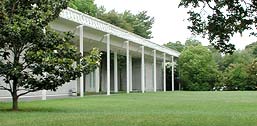|
amy storrowSEE a slide show of the Menil Museum and some of the works in its famous collection. SEE a video and hear the former director of the Menil Collection talk about a Twombly masterwork. (Thanks to the Houston production company Ttweak for the video.) SEE a picture of Dan Flavin's installation "Richmond Hall" in Richmond Hall. Central to Doville's charm as a mecca for art lovers are the Menil Collection, The Cy Twombly Gallery and the Dan Flavin Installation in Richmond Hall. The Menil Collection, which opened in 1987, preserves and presents the private art collection of Dominique and John de Menil. The museum also welcomes special and travelling exhibits. It houses the world's foremost collection of Surrealist work plus masterpieces from Antiquity, the Byzantine and medieval worlds, the tribal cultures of Africa, Oceania and the American Pacific Northwest. The building itself is considered a true triumph of modern architecture. The museum was designed by a joint venture between Renzo Piano/Building Workshop, Genoa, Italy and Richard Fitzgerald & Partners, Houston. Famous for its ingenious roof and skylight system and interior atrium gardens, the museum is fused with natural light and a sense of the natural landscape. The building is long and low. It doesn't loom or dominate the neighborhood and its surrounding lawn and careful installation of Michael Heizer earthworks invite the local residents to use it as a communal space. The museum is painted the same shade of grey as the surrounding bungalows some of which house nonprofit arts organizations and some of which house artists, writers, musicians and architects. All three museums are free. The Cy Twombly Gallery, also designed by Renzo Piano, is a smaller, more intimate space than the Menil, but no less elegant or tranquil. It too has a sophisticated roofing system that allows for an even diffusion of natural light. During the building's design Twombly talked of not including any artificial light sources at all. When someone suggested that then there would be no way to view his work at night, Twombly replied, "You don't look at art at night, you go have a drink." But the gallery staff's desire for some nighttime activity prevailed and there are a few subtly placed lights. The Gallery is organized to showcase Twombly's work both thematically and chronologically. It is rare for a living artist to have a gallery dedicated to the permanent installation of his work. But Twombly, who was born in Lexington, VA in 1928 and settled permanently in Italy, has been wildly influential to recent generations of American painters and the de Menils were both fans and patrons. Richmond Hall used to be a grocery store. Now it houses the penultimate work by the Minimalist sculptor Dan Flavin. The installation features two rows of flourescent tubes stacked but not exactly on top of each other that creates a kind of visual doppler effect. Flavin was probably (with James Turrell) America's most important and innovative artist ever to work with light as his medium. Richmond Hall is set apart from the neighborhood's other two museums. It's on one of the busier border streets, Richmond, and it's next to a parking lot. Richmond Hall is an easy walk from both the Menil and the Twombly Gallery. And coming into the space from the urban hustle of Richmond renders the installation all the more startling and eerie and beautiful. Contents Copyright 2001, National Public Radio |
|||||||


